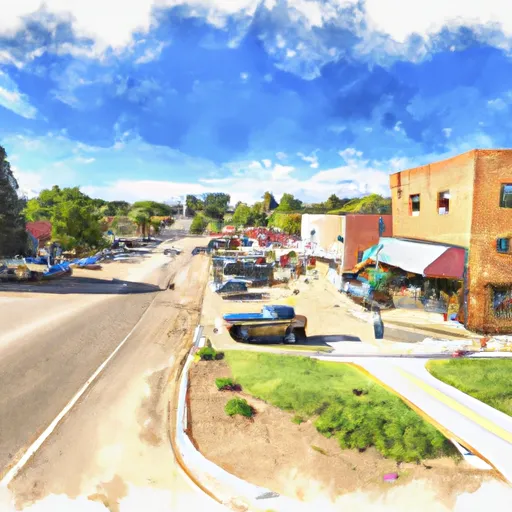-
 Snoflo Premium
Snoflo Premium
Get unlimited access to all our content
With no Ad interruptions! - Start Your Free Trial Login with existing account
Mc-Coy
Eden Index
Climate
6.7
•
Recreation
3.0
•
Community
•
Safeguard
3.7/10

Mc-Coy, Colorado is a small unincorporated community located in Eagle County. It is situated in the Colorado River Valley, surrounded by majestic mountains and stunning natural beauty. The climate in Mc-Coy is characterized by cool summers and cold winters. Summers are mild, with average temperatures ranging from the 60s to the 80s Fahrenheit, while winters are snowy and cold, with temperatures often dropping below freezing.
Hydrology plays a vital role in Mc-Coy, as it is situated near the Colorado River. The river, along with various streams and creeks, provides essential water resources for the community and supports a diverse range of aquatic ecosystems.
Mc-Coy offers a plethora of outdoor recreation opportunities. The nearby mountains provide excellent opportunities for hiking, mountain biking, and off-roading. Fishing enthusiasts can enjoy casting their lines in the Colorado River and various nearby lakes and streams, which are home to a variety of trout species. Hunting is also popular in the area, with opportunities for big game hunting.
In conclusion, Mc-Coy, Colorado offers a picturesque setting with a climate characterized by cool summers and cold winters. Its proximity to the Colorado River provides essential water resources and supports various outdoor activities such as hiking, fishing, and hunting.
What is the Eden Index?
The Snoflo Eden Index serves as a comprehensive rating system for regions, evaluating their desirability through a holistic assessment of climate health, outdoor recreation opportunities, and natural disaster risk, acknowledging the profound impact of these factors on livability and well-being.
Climate Health Indicator (CHI): 6.7
Mc-Coy receives approximately
313mm of rain per year,
with humidity levels near 58%
and air temperatures averaging around
6°C.
Mc-Coy has a plant hardyness factor of
4, meaning
plants and agriculture in this region thrive during a short period during spring and early summer. Most
plants will die off during the colder winter months.
By considering the ideal temperature range, reliable water supplies, clean air, and stable seasonal rain or snowpacks, the Climate Health Indicator (CHI) underscores the significance of a healthy climate as the foundation for quality living.
A healthy climate is paramount for ensuring a high quality of life and livability in a region, fostering both physical well-being and environmental harmony. This can be characterized by ideal temperatures, reliable access to water supplies, clean air, and consistent seasonal rain or snowpacks.
Weather Forecast
Streamflow Conditions
Colorado Headwaters
Area Rivers
Colorado Headwaters
Snowpack Depths
Colorado Headwaters
Reservoir Storage Capacity
Colorado Headwaters
Groundwater Levels
Recreational Opportunity Index (ROI): 3.0
The Recreational Opportunity Index (ROI) recognizes the value of outdoor recreational options, such as parks, hiking trails, camping sites, and fishing spots, while acknowledging that climate plays a pivotal role in ensuring the comfort and consistency of these experiences.
Access to outdoor recreational opportunities, encompassing activities such as parks, hiking, camping, and fishing, is crucial for overall well-being, and the climate plays a pivotal role in enabling and enhancing these experiences, ensuring that individuals can engage in nature-based activities comfortably and consistently.
Camping Areas
| Campground | Campsites | Reservations | Toilets | Showers | Elevation |
|---|---|---|---|---|---|
| Fulford Cave | 7 | 9,422 ft | |||
| Gypsum | None | 6,286 ft | |||
| Dearhamer | 13 | 7,792 ft | |||
| Little Maud | 20 | 7,808 ft | |||
| Mollie B | 27 | 7,895 ft | |||
| Elk Wallow | 7 | 8,829 ft | |||
| Chapman | 84 | 8,598 ft | |||
| Little Mattie | 22 | 7,911 ft | |||
| Yeoman Park | 24 | 9,062 ft | |||
| Sylvan Lake State Park | 44 | 8,535 ft |
Nearby Ski Areas
Catastrophe Safeguard Index (CSI):
The Catastrophe Safeguard Index (CSI) recognizes that natural disaster risk, encompassing floods, fires, hurricanes, and tornadoes, can drastically affect safety and the overall appeal of an area.
The level of natural disaster risk in a region significantly affects safety and the overall livability, with climate change amplifying these risks by potentially increasing the frequency and intensity of events like floods, fires, hurricanes, and tornadoes, thereby posing substantial challenges to community resilience and well-being.
Community Resilience Indicator (CRI):
The Community Resilience Indicator (CRI) recognizes that education, healthcare, and socioeconomics are crucial to the well-being of a region. The CRI acknowledges the profound impact of these elements on residents' overall quality of life. By evaluating educational resources, healthcare accessibility, and economic inclusivity, the index captures the essential aspects that contribute to a thriving community, fostering resident satisfaction, equity, and social cohesion.

